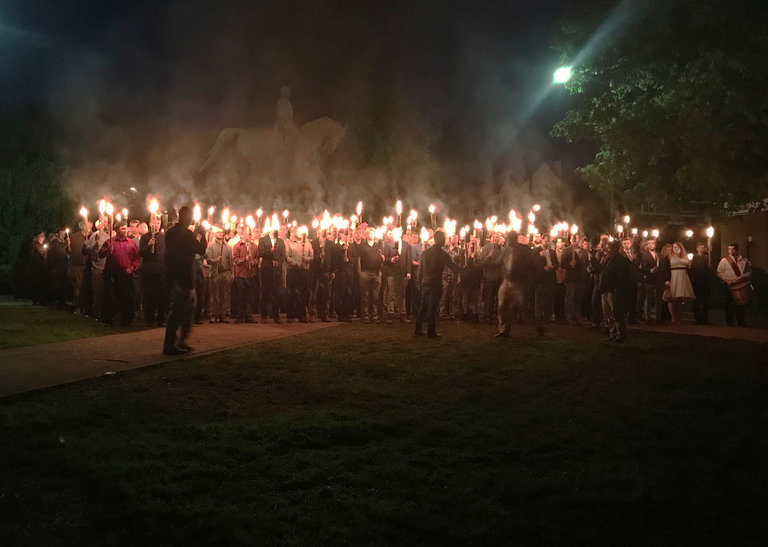Confederate Monuments Falsely Glorify a Racist Past
BY DAN DASKAL

A single vote by the Charlottesville, Va., city council has shined a spotlight on multiple lines of conflict running throughout the United States. The council’s contentious vote to remove a statue of Confederate General Robert E. Lee from a local park galvanized a group of white nationalists to organize a nighttime protest, during which they wielded torches and chanted Nazi-era slogans. Charlottesville’s mayor, Michael Signer, voted against the removal of the statue and stated that the gathering was “either profoundly ignorant or was designed to instill fear in our minority populations in a way that hearkens back to the days of the KKK.” Following his denouncement of the protest, Signer, who is Jewish, received a barrage of anti-Semitic tweets from white nationalists.
These events serve as a stark reminder of racist groups’ resilience throughout the nation. Many of these extremists take pride in what they view as the courage of the Confederates in their fight against a tyrannical federal government, and the white nationalists in Charlottesville remain a vocal minority. A prominent reason cited for opposing the removal of Confederate monuments—and the reason given by Signer—is that “if we don’t remember the past, then we’ll be condemned to repeat it.” This sentiment provides its proponents with a powerful argument for maintaining the widespread symbols of the Confederacy; however, they are entirely unnecessary for preserving history. The many public monuments, memorials and waving Confederate battle flags serve not as a reminder of history, but as a source of fear and disgust for blacks and others who perceive them as symbols of oppression and racism. The same argument for remembering history is made for the Holocaust, yet swastikas and other Nazi-related symbols have long been relegated to museums and other places of learning where they belong.
Leaving symbols of the Confederacy intact in public places has instead helped fuel the distortion of its history. The dissemination of myths regarding the Civil War, such as that the South seceded due to its belief in states’ rights or that General Lee was an abolitionist, has served to minimize the role of slavery in the war and has contributed to the idolization of the Confederacy. Many in the South continue to glorify Confederate generals, as their prowess was the Confederacy’s greatest asset. Since this period, many in the South have felt slighted by the widespread negative perceptions held by coastal elites, leading them to cling to a romanticized version of the past. In St. Louis, Mo., officials are working to remove a thirty-two-foot tall monument honoring Confederate soldiers. According to Human Services Director Eddie Roth, who is heading the project, “The Confederate monument in St. Louis is replicated in cities across the country, and was a multi-generational propaganda effort, mainly led by Confederate women to recast the South’s role in the Civil War. You won’t find anything about slavery, even though that was a principal part of the war.” Many in the South believe that the valor of those fighting in the Confederacy should be honored, as these soldiers stood up for their beliefs and fought against an overreaching federal government. Although the origin of the Civil War is a complex issue, its roots lie in slavery. Regardless of the declining profitability of the institution of slavery, the ideology built around its history prevailed, leading Southerners to fight to maintain it. The Union fought to stop its expansion and to create a unified United States of America. The Confederacy, on the other hand, strived to maintain the outdated economy of the Antebellum era, which was driven by wealthy plantation owners. This economic success, however, was built on the backs of slaves, leading Southern leaders to fight against the abolition of slavery in an effort to maintain their power.
Today, monuments to the Confederacy are a testament to a divided United States of America. All observations must filter through the lens of one’s perspective. As exhibited by the reactions to the planned removal of the statue in Charlottesville, a single event will often evoke a host of disparate reactions from observers. In some regards, the era of Reconstruction has successfully bridged many of the nation’s great divides, yet all too many remain today. While a host of Americans are appalled and disgusted by monuments glorifying the Confederacy, others take issue with any attempts to remove them. It is essential to remember history to learn from past mistakes; however, these grand memorials to the Confederacy constitute an attempt to warp history rather than preserve it.
